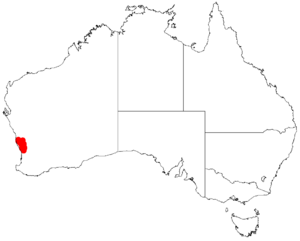Acacia cummingiana facts for kids
Quick facts for kids Acacia cummingiana |
|
|---|---|
| Conservation status | |
| Scientific classification | |
| Genus: |
Acacia
|
| Species: |
cummingiana
|
 |
|
| Occurrence data from AVH | |
Acacia cummingiana is a special kind of shrub. It belongs to a large group of plants called Acacias. This plant is only found in a small part of Western Australia. It grows on the flat coastal areas and sandy plains.
What Does It Look Like?
This shrub often spreads out low to the ground. It looks a bit like a rush plant. It usually grows to be about 0.3 to 0.5 metres (1.0 to 1.6 ft) tall.
It blooms with bright yellow flowers. You can see these flowers between May and August. Its branches are green with yellow stripes. The leaves, called phyllodes, are thin and flat. They look like tiny triangles and are about 1.5 to 4 millimetres (0.059 to 0.157 in) long.
The flowers grow in round clusters. Each cluster is about 8 mm (0.315 in) wide. There are usually 8 to 12 flowers in each cluster. After the flowers, the plant grows seed pods. These pods are slightly curved. They are about 4 to 7 centimetres (1.6 to 2.8 in) long and 8 to 10 mm (0.31 to 0.39 in) wide. Inside, the seeds are oval-shaped and about 5 mm (0.197 in) long.
How Was It Named?
The scientific name for this plant was first given in 1995. A botanist named Bruce Maslin officially described it. He wrote about it in a scientific paper. The paper was part of a journal called Nuytsia.
For a short time in 2003, its name was changed. Another scientist, Leslie Pedley, called it Racosperma cummingianum. But by 2006, it was changed back to Acacia cummingiana.
Where Does It Grow?
Acacia cummingiana is found in Western Australia. You can see it from Chittering in the south. It grows as far north as Dadaragan.
It likes to grow in sandy areas. Sometimes it's found on rocky cliffs called breakaways. The soil can be grey or yellow sand. It also grows in gravelly soil that contains laterite. This plant often lives in areas with dense bushes. It can also be found in open woodlands. There, it grows alongside other plants like Banksia prionotes and Eucalyptus todtiana.


